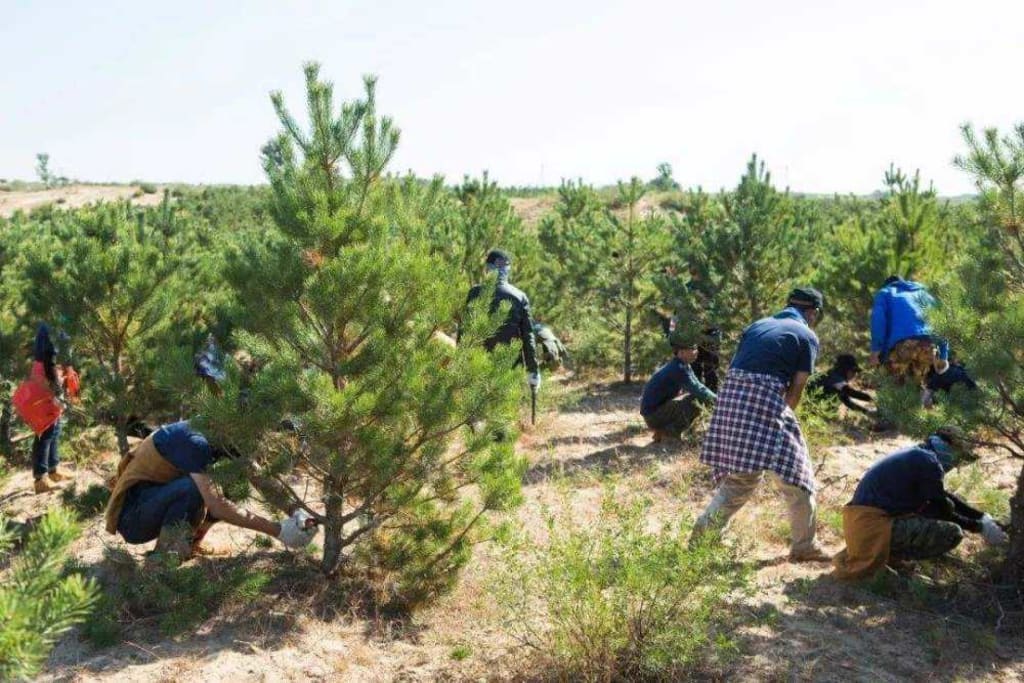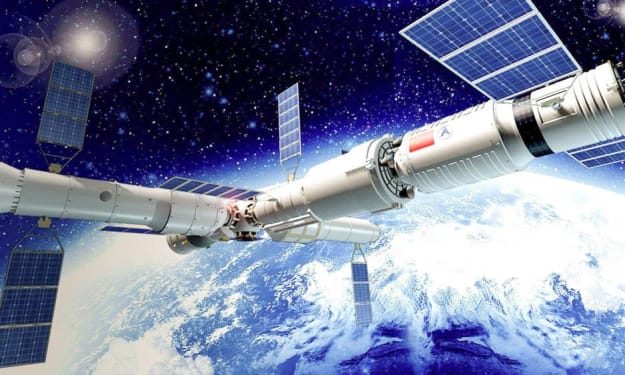
China is not only an infrastructure monster, but also a plant monster.
Perhaps we have not noticed that many deserts in China are gradually shrinking, even like the Mu Us desert directly disappeared from the map.
In the course of long-term battle of wits with desert, China cultivated a "swallow sand god beast", which can make 40 acres of sand disappear one day.
So what kind of beast eats sand?
"The Sand-eating Monster"
Swallow sand is not an animal, but a car, called multifunctional three-dimensional sand fixing car, is designed to help people in the desert governance desert, plant trees.
As we all know, planting trees in the desert is no less difficult than Tang's pilgrimage to the West.
The first is to choose the location, not just any desert can grow plants, you have to choose the sand with groundwater.
Therefore, desert planting often starts from the edge of the desert, from the outside in.
Once the location is found, the planting project cannot be carried out easily, and the right tree species must be selected.
Banyan trees, poplars and willows, which are common to us, cannot survive in desert areas.
To be exact, in the beginning, desert trees were planted with low shrubs, such as seabuckthorn and Achnatherum splendens.
Using their roots to stabilize water sources and the soil beneath the desert, they provide a good base for later planting.
Splendens in desert
Because desert plants have very long root systems, they need to be planted in deeper holes than other plants.
The weather in the desert is very bad, the sun is exposed during the day, once the wind, it is directly all over the sky sand.
It is possible to dig a hole one second, the next second to be filled with sand. Sand can also destroy plants that have been planted, causing them to be uprooted.
Despite these difficulties, our country has not flinched. Over the past 40 years, we have planted 66 billion trees, a true "tree monster."
The dust storm is coming
This is due to the efforts of countless sand-controlling people from generation to generation, many of them even died in the process of planting trees.
In order to improve the working conditions of sand control people and help them better plant trees, in 2016, Liu Jinhao team of Beijing Forestry University developed a multi-functional three-dimensional sand fixing car, set sand fixing, planting and other functions in a car, can help control 40 mu of desert area in a day, is known as the "sand giant beast".
Beast devoured
Desert tree planting is a long line of work, and there is a lot of extra work to be done, such as laying the grass grid beforehand.
This grass grid is an original sand control method, which is used for sand fixation and lays a good foundation for planting higher plants later.
The straw grid uses wheatgrass, which needs to be selected to fit the length of the wheatgrass and placed on the grid line drawn in advance.
Make SURE THAT THE CENTER OF each STRAW is on the LINE, then use the spade to put it in the middle of the straw and press it hard into the sand, so that the straw stands in the desert.
Grass grid in the desert
This process is very long and complex, and it was basically manually selected, manually placed and manually pressed before, and the efficiency is relatively slow.
Multi-function three-dimensional sand fixing truck is upgraded by using the principle of seed drill.
The wheatgrass is compressed into wheatgrass rolls and put into the car. The sand fixing truck will distribute the wheatgrass by itself when it is working, and then accurately put it on the line, and then use its roller tray to press the wheatgrass into the sand.
In just one day, it can cover 40 acres of sand.
It can not only lay grass grid, but also plant trees. It can plant 2,000 saplings in an hour.
The multi-functional sand-fixing vehicle only takes 3 to 6 months to complete the desert area that originally needed a sand-controlling person to complete a year.
In 2017, Gansu decided to buy a multi-functional three-dimensional sand-fixing truck for its 3,700 mu desert area.
The workers see this big guy is very curious, after seeing it work, have to sigh the great science and technology, they used to work a day, this car less than an hour to finish.
Because OF the multi-functional stereo sand fixing truck love, we call it "sand swallowing giant beast", hope it swallowed our country's desert.
Why does China hate desertification so much? Because China has suffered from desertification for the past 70 years.
Harm of desertification
I don'tknow if you still remember, in the past weather forecast, there would be frequent sandstorms, but now, it is very rare to hear the news of sandstorms.
The most serious desertification is China's northwest, North China, as long as the wind together, Beijing, Tianjin, Xi 'an and other cities will be covered by the yellow sand.
The main reason lies in the degradation of grassland caused by overcultivation and grazing, and the result of the degradation is desertification.
When grasslands become desertified, they suffer from severe soil erosion, leaving the land desolate and carrying sediment into nearby rivers.
A city under a sandstorm
For example, in the past, there was half a bowl of sand in the water of the Yellow River in China.
The reason is that the land on the Loess Plateau has become so desertified that sediment flows into the Yellow River whenever it rains.
After desertification, the land can not be cultivated or grazed, which is equivalent to a piece of land directly wasted. We should know that land is also a resource, which is a huge loss for human beings.
Especially our country's large population, so it needs a very large cultivated land area, if these land is wasted, can greatly influence the output of grain production and the development of livestock husbandry.
China's main pastures are in Xinjiang and Inner Mongolia, and if desertification is allowed to spread, the pastures will be swallowed up by the desert.
My country will be a double whammy when the time comes. It has lost its farmland as well as its grazing land.
Therefore, since its founding, our country has devoted itself to eliminating these extra deserts.
Just IN THE PAST, THE degree of mechanization is not high, our desert management is artificial, the efficiency is slow, a lot of sand control people also left the root of disease.
Artificial sand
How to govern effectively becomes the key. This multi-functional three-dimensional sand fixing car is not out of thin air, before this countless engineers are starting to study mechanized sand control, now really realized.
From 2000 to 2017, China accounted for a quarter of the world's greening, according to NASA satellite images.
And the green area in China is not dragged up by arable land like in India. The green area in China is actually planted trees.
Forest and arable land
Some people may wonder, the crops on the cultivated land are plants, and the trees are also plants. Why is the greening of the cultivated land harmful to the environment rather than improving it?
First, trees do not stabilize water and soil, whereas crops do not.
Trees have strong roots that can penetrate deep into the soil and spread over large areas, but crops have shallow roots that do little to stabilize the soil.
Not only do crops fail to stabilize the soil, they absorb water, store it in their bodies, and as people pull it away, it goes somewhere else, causing serious water loss.
An Indian's rice field
Secondly, because crops have been cultivated by humans, they are particularly able to absorb nutrients from the soil, and the soil that has been planted basically needs to be fertilized to continue the cultivation of the next season.
Fertilization, however, causes the soil to flat10 and become dry, unable to evaporate water properly.
Soil water evaporation is an important part of the water cycle transpiration. Crops destroy the water cycle and affect the local normal precipitation.
Finally, crops do not form ecosystems; they exist mainly in artificial environments.
The Indian harvest
But forests are great for nature as a whole by being able to host more creatures, provide them with food and habitat.
In arid environments like deserts, the Chinese approach is to fix sand and then plant low dryland shrubs to fix the soil and water through their roots. When the soil and water are sufficiently fixed, planting trees is the ultimate goal.
For the global environment, India's growing cropland will have no positive effect and will increase the rate of destruction in the future.
The increase in forest area in China, which is real greening, has a positive effect on neutralizing carbon in the atmosphere and optimizing air quality.
What's more, China has let a piece of the desert disappear, which is a miracle in the history of human sand control.





Comments
There are no comments for this story
Be the first to respond and start the conversation.